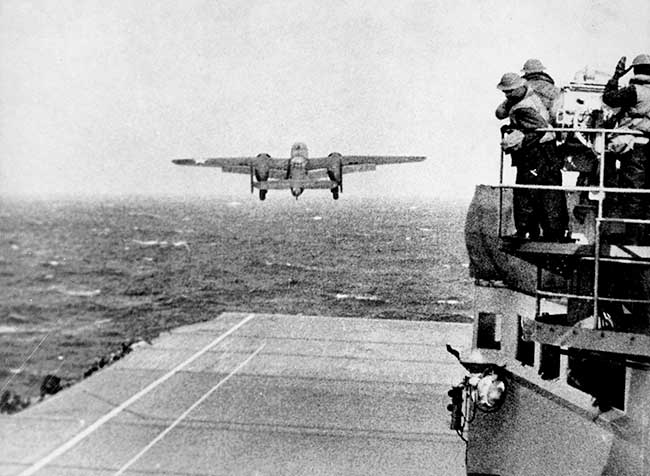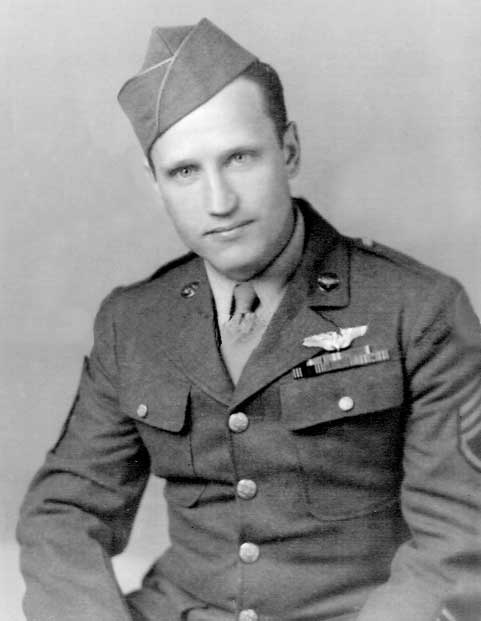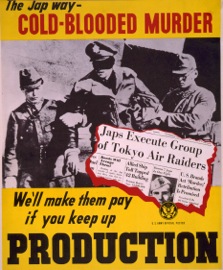A Behind-the-Scenes Story of the Doolittle Raid: After Infamy, Forgiveness Wins
A Behind-the-Scenes Story of the Doolittle Raid: After Infamy, Forgiveness Wins
by Linda Thompson
Seventy-five years ago today, just six months after the attack on Pearl Harbor, eighty volunteers took flight on a daring mission that would have a profound impact on the War in the Pacific.

Six months after Pearl Harbor, U.S. forces enact an unprecedented plan. An Army B-25 bomber takes off from the carrier U.S.S. Hornet 400 miles off the coast of Japan. Fifteen of the sixteen planes crashed in provincial China.
In an action history has dubbed the Doolittle Raid, sixteen B-25 bombers left the deck of the carrier U.S.S. Hornet. They deployed their payloads on Tokyo and other key targets on the Japanese main island.
The mission has been somewhat forgotten in the mists of time, but it triggered a media sensation then. “U.S. Warplanes Rained Bombs on Leading Cities of Japanese Empire,” the newspapers crowed. The raid inspired a pair of wartime motion pictures (Thirty Seconds Over Tokyo and The Purple Heart), both released in 1944. But while the military objective was achieved, due to unforeseen circumstances the sortie left most of the airmen stranded in enemy-occupied China. Eight men—survivors from two planes that crashed when they ran out of fuel—were captured by the Japanese.
Anyone who saw the movie or read the book Unbroken will have a general picture of what these men endured. But where Louis Zamperini was a prisoner for a little more than two years, Doolittle’s “lost crews” remained in Japanese prison camps
… for forty long months, 34 of them in solitary confinement. We were imprisoned and beaten, half-starved, terribly tortured, and denied by solitary confinement even the comfort of association with one another. Three of my buddies were executed by a firing squad about six months after our capture and fourteen months later, another one of them died of slow starvation.… The bitterness of my heart against my captors seemed more than I could bear.
- Corporal Jacob DeShazer in his tract I Was a Prisoner of Japan
Of the eight Raiders captured, only four survived. George Barr, Jacob DeShazer, Robert Hite and Chase Nielson returned to the U.S. different men. Here’s how they expressed it in a joint statement:
We were not what you would call religious men before we were captured. We went to Sunday school and church when we were kids… We memorized Bible verses and listened to sermons and said grace at meals. We knew the Ten Commandments. But we never really understood the meaning behind those words and the source of strength they represented in our lives.…
We were given the Bible to read. We found in its ripped and faded pages a source of courage and faith we never realized existed. The verses we memorized as children suddenly came alive and became as vital to us as food.
We put our trust in the God we had not really accepted before and discovered that faith in His Word could carry us through the greatest peril of our lives.
—Four Came Home (Carroll V. Glines, 1995)
Corporal Jacob DeShazer, the former bombardier of the Bat Out of Hell, was transformed by what he read in the Bible. The Lord revealed to him during those miserable hours in his cell that He wanted to give the Japanese people an illustration of the meaning of forgiveness. Jake was to be that walking object lesson.

Sargeant Jacob DeShazer after the war. This photo appeared on the cover of the tract Fuchida read.
To fulfill that calling, Jake rushed to earn a Bible degree from Seattle Pacific College when he got home. In 1948, he returned to Japan with his new bride, Florence, as a Free Methodist missionary.
This time I was not going as a bombardier, but I was going as a missionary. How much better it is to go out to conquer evil with the gospel of peace! The strength and power must come from God, but God's promise is, “I have set before thee an open door, and no man can shut it.” (Revelation 3:8)
—Jacob DeShazer on his return to Japan
Japanese people flocked to hear him. They peppered him with questions. At that time, the idea that one could hold anything other than implacable hatred for one’s enemies was foreign to their culture.
There are a number of remarkable stories from Jake and Florence’s sojourn in Japan. The most famous is that of Mitsuo Fuchida, who commanded the air attack on Pearl Harbor.
A celebrated hero in Japan during the war, its loss left Fuchida to eke out a living as a subsistence-level farmer. This gave him time to ask the existential questions. “As I labored on the farm I thought of God, creation, the miracles of the seasons, the growing plants. These things never failed to awe me.” Impressed by DeShazer’s participation in the Doolittle Raid, he picked up a tract Jake had authored. It made him curious about the Bible.
Fuchida acquired a Bible and read it. In Jesus’ words from the cross, he found the answers he’d been seeking. “Father, forgive them, for they know not what they do” (Luke 23:24). Fuchida recognized the forgiveness Jesus spoke from the cross extended even to a twentieth-century Japanese warrior. He knew he’d reached the end of a “long, long wandering…. This new element enriched my life—the knowledge of Christ.” (God’s Samurai, Prange, Goldstein and Dillon, 1990)
A few months later, the two were preaching to crowds together—the Doolittle Raider and the Japanese captain who gave the infamous “Tora-tora-tora” signal that launched the Pearl Harbor attack. They brought to thousands the message of God’s sacrificial love for all people and the power of forgiveness through Jesus Christ.

This wartime poster features a photo of Lieutenant Robert Hite, one of eight captured Doolittle Raiders. Tokyo, April 1942.
Jake and Flo ultimately settled in Nagoya, the very city Jake had bombed. Their thirty-year ministry in Japan bore fruit in twenty-three church plants and in many changed hearts.
In a fascinating parallel, Fuchida revisited Honolulu and handed out Bibles. He told one recipient, “I came with bombs once, but now I come with the Bible. Jesus Christ is the answer.”
In researching my novel inspired by the experience of Doolittle’s lost crews, I learned that Jake’s story is not unique. General MacArthur, commander during the U.S. occupation of Japan, recognized the spiritual void left by the demise of Japan’s prewar militarist ideology. He begged the major denominations to send missionaries. Thousands of people responded. Many of these were men who’d battled the Japanese across the Pacific then felt called to serve them in ministry after the war.
DeShazer’s vision was to see Japan become a "Christian nation." While this didn't happen, tens of thousands of Japanese individuals responded to the gospel of Jesus Christ. The Bible was a bestseller in the years after the war. So was The Bells of Nagasaki, a personal testimony / philosophical treatise by Japanese Christian Nagai Takashi. Nagai wrote the book while he was dying of radiation poisoning.
Only the Lord knows the full impact of the Christ-like devotion of His dedicated servants such as the DeShazers, the Fuchidas, and the Nagais.
Bio: Linda Thompson blogs on the topic Five Stones and a Sling: Stories of Reckless Faith at lthompsonbooks.com. WordServe Literary is currently shopping her first novel, The Plum Blooms in Winter, inspired by the story of Doolittle’s “lost crews.”
For more on faith during and after World War II, see Christian History magazine #121, Faith in the Foxholes.



